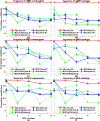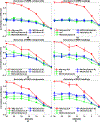aNy-way Independent Component Analysis
- PMID: 33018341
- PMCID: PMC8258844
- DOI: 10.1109/EMBC44109.2020.9175277
aNy-way Independent Component Analysis
Abstract
Multimodal data fusion is a topic of great interest. Several fusion methods have been proposed to investigate coherent patterns and corresponding linkages across modalities, such as joint independent component analysis (jICA), multiset canonical correlation analysis (mCCA), mCCA+jICA, disjoint subspace using ICA (DS-ICA) and parallel ICA. JICA exploits source independence but assumes shared loading parameters. MCCA maximizes correlation linkage across modalities directly but is limited to orthogonal features. While there is no theoretical limit to the number of modalities analyzed together by jICA, mCCA, or the two-step approach mCCA+jICA, these approaches can only extract common features and require the same number of sources/components for all modalities. On the other hand, DS-ICA and parallel ICA can identify both common and distinct features but are limited to two modalities. DS-ICA assumes shared loading parameters among common features, which works well when links are strong. Parallel ICA simultaneously maximizes correlation between modalities and independence of sources, while allowing different number of sources for each modality. However, only a very limited number of modalities and linkage pairs can be optimized. To overcome these limitations, we propose aNy-way ICA, a new model to simultaneously maximize the independence of sources and correlations across modalities. aNy-way ICA combines infomax ICA and Gaussian independent vector analysis (IVA-G) via a shared weight matrix model without orthogonality constraints. Simulation results demonstrate that aNy-way ICA not only accurately recovers sources and loadings, but also the true covariance/linkage patterns, whether different modalities have the same or different number of sources. Moreover, aNy-way ICA outperforms mCCA and mCCA+jICA in terms of source and loading recovery accuracy, especially under noisy conditions.Clinical Relevance-This establishes a model for N-way data fusion of any number of modalities and linkage pairs, allowing different number of non-orthogonal sources for different modalities.
Figures






References
-
- Liu JY, Pearlson G, Windemuth A, Ruano G, Perrone-Bizzozero NI, and Calhoun V, “Combining fMRI and SNP Data to Investigate Connections Between Brain Function and Genetics Using Parallel ICA,” (in English), Hum Brain Mapp, vol. 30, no. 1, pp. 241–255, January 2009, doi: 10.1002/hbm.20508. - DOI - PMC - PubMed
MeSH terms
Grants and funding
LinkOut - more resources
Full Text Sources
Miscellaneous
